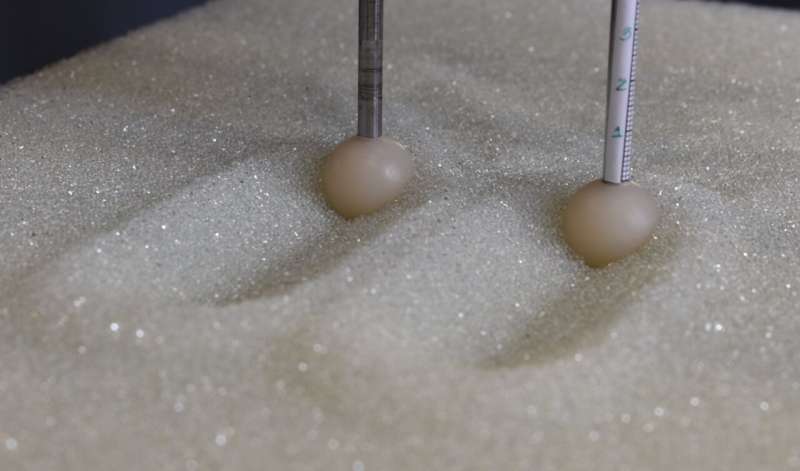
December 28, 2024 by D. D. Carvalho, Y. Bertho, A. Seguin, E. M. Franklin, and B. D. Texier
Collected at: https://phys.org/news/2024-12-cooperation-intruders-side-granular-media.html
In bird colonies, schools of fish and cycling pelotons, significant interactions occur between individuals through the surrounding fluid. These interactions are well understood in fluids such as air and water, but what happens when objects move through something like sand? It turns out that similar interactions occur in granular materials—things like soil or sand—and they play a crucial role in everyday contexts. Think of plows cutting through farmland, animals burrowing underground, roots pushing through soil, or even robots exploring the surface of Mars.
Recently, we came across a fascinating discovery: When two objects—what we call “intruders”—move side by side through granular materials, they can actually help each other by reducing the resistance they face. This cooperative effect was uncovered by a team of researchers from the School of Mechanical Engineering at the University of Campinas (UNICAMP) in Brazil, and the FAST laboratory, CNRS, Université Paris-Saclay in France.
To investigate this, we set up an experiment using spherical objects immersed in glass beads to replicate a granular medium. The goal was to pull these objects at a constant speed and measure the drag force they experienced as they moved through the grains. While previous studies had looked at the lateral forces between objects, our team wondered whether moving together might also reduce the drag force.
Some intriguing numerical simulations by two of our researchers at UNICAMP, D. D. Carvalho and E. M. Franklin, published in the Physics of Fluids in 2022, suggested that it could, but we wanted to test this in the real world.
What we found was exciting: When the two intruders were close together, the drag on each of them dropped significantly—by as much as 30% compared to when they were farther apart. And the deeper they were buried in the material, the more pronounced this effect became. The explanation? When two objects move side by side, the motion of one disrupts the force chains between the grains around the other. This break in the grain contact reduces the overall resistance each object encounters.
Beyond just observing this effect, we also developed a semi-empirical model to describe it. The model is based on the idea that interactions between closely spaced objects disrupt these granular force chains, making it easier for them to move. This study, now published in Physical Review Fluids, highlights a previously under-explored aspect of granular dynamics: the cooperative motion of multiple objects.
As research into these dynamics advances, it may lead to new technologies and techniques for navigating granular materials—on Earth and beyond—potentially enabling more efficient solutions for various industries and scientific endeavors.
This story is part of Science X Dialog, where researchers can report findings from their published research articles. Visit this page for information about Science X Dialog and how to participate.
More information: D. D. Carvalho et al, Drag reduction during the side-by-side motion of a pair of intruders in a granular medium, Physical Review Fluids (2024). DOI: 10.1103/PhysRevFluids.9.114303
Journal information: Physical Review Fluids , Physics of Fluids

Leave a Reply